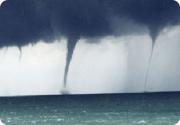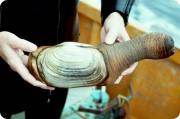Radio Program
Our regular Science and the SeaTM radio program presents marine science topics in an engaging two-minute story format. Our script writers gather ideas for the radio program from the University of Texas Marine Science Institute's researchers and from our very popular college class, Introduction to Oceanography, which we teach to hundreds of non-science majors at The University of Texas at Austin every year. Our radio programs are distributed at to commercial and public radio stations across the country.
Residents of the Florida Keys are on the alert for marine storms at this time of year -- and not just hurricanes. Much smaller storms twist around the island chain, too -- up to several hundred a year. They look like skinny tornadoes -- rope-like funnels that twist across the water for a few minutes.
Water spouts are most common around the Keys, but they’re found in other coastal regions around the country and around the world.
Smugglers sneak tons of it out of the country every year. Other ne’er-do-wells under-report the amount of it they’ve sold on their incomes taxes, and even trade drugs for it. Is it diamonds? Gold? Lady Gaga CDs?
How about the world’s largest burrowing clam -- a monster with a three-foot neck that can live for more than a century. It’s a delicacy on both sides of the Pacific Ocean -- fetching up to $60 a pop in parts of Asia.
“Snowbirds” are popular visitors along the Texas coast -- people who flee the cold northern winters for the warm beaches. And over the last third of a century, those beaches have been getting a little warmer. At Corpus Christi, for example, the winter temperature has climbed by about five degrees Fahrenheit.
{mosimage}
It sounds like something from an episode of the original “Iron Chef.” Take two halves of a coconut shell, place an octopus inside, then simmer in saltwater.
Except for the “simmer” part, it’s a recipe that a species of octopus created on its own. It’s the first clear example of an octopus using tools to improve its life.
Marine biologists already knew that octopuses are smart. They use pebbles to wall up the entrances to their dens, and in captivity, they can pry open the tops of their tanks and dip their arms into other tanks.
Most of us have little trouble naming the world’s largest coral reef system. It’s Australia’s Great Barrier Reef -- 1600 miles of coral, aquamarine waters, and other natural wonders.
The second-largest reef system is no less wondrous. But it’s pretty much anonymous, even though it’s not that far from home.
Vast ribbons of life undulate across the oceans and seas. They’re packed with fish, sea turtles, and sometimes even wriggling masses of sea snakes. These ribbons are known as driftlines. They’re collections of floating seaweed, sticks, and other debris. They form at the boundaries between ocean currents, where the debris is pushed together to form patches or lines. Some are fairly small, but others can stretch for miles.
The creatures that live in the deep ocean don’t have to be big to be scary. Consider an animal that’s only about a foot long, and about the same consistency as a jellyfish. Its spooky appearance earned it a spooky name: Vampyroteuthis infernalis -- “vampire squid from hell.”
Saudi Arabia is home to some of the most desolate land on Earth. In the giant Rub Al-Khali and an-Nafud deserts, temperatures can soar to 140 degrees Fahrenheit, and frequent sandstorms fill the sky with choking dust. Yet not so far from the desert, life is abundant: in the extensive coral reefs of the Red Sea. Saudi Arabia’s Red Sea coastline is about 1100 miles long, and coral reefs fringe most of it. They’re home to several hundred species of coral, plus hundreds more species of fish, crustaceans, and other creatures.
The guy who came up with the expression “drinking like a fish” knew what he was talking about. Although it sounds a little kooky, saltwater fish have to guzzle saltwater to help them survive in a saltwater environment.
A fish has to maintain the proper amount of sodium, chloride, and other dissolved minerals -- the “salt” in saltwater -- in its tissues.
But the water around the fish doesn’t want to cooperate. It tries to even out the distribution of freshwater and saltwater by passing through a fish’s skin and gills.
TV shows like “Planet Earth” and “The Blue Planet” offer spectacular views of life in the oceans. These programs were made possible in large part by the work of a single man. He helped develop underwater photography and scuba diving, and he hosted the first TV show that regularly transported viewers into the undersea realm.




